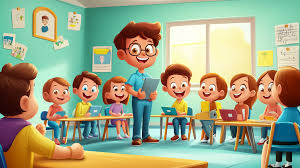In today’s digital age, the classroom experience extends far beyond textbooks and worksheets. Innovative teachers are discovering the untapped potential of using kids animated shows as powerful educational tools. These colorful, engaging programs often contain rich educational content disguised as entertainment, making them perfect supplements to traditional teaching methods. When properly integrated into lesson plans, these shows can transform abstract concepts into concrete, visual examples that resonate with young learners.
The strategic use of animation in education represents a meeting point between entertainment and learning. Teachers who incorporate kids animated shows into their curriculum often report increased student engagement, improved retention of information, and more enthusiastic class participation. This approach acknowledges the reality that today’s children are digital natives, accustomed to processing information through screens and visual storytelling. By speaking their language, educators can bridge the gap between traditional education and the media-rich world children inhabit outside school walls.
Educational psychologists have long recognized the power of visual learning. When children watch animated characters navigate challenges, solve problems, or explore new concepts, they’re not merely being entertained—they’re absorbing information through multiple sensory channels. The combination of colorful visuals, memorable characters, engaging storylines, and carefully crafted dialogue creates a rich learning environment that can reinforce classroom lessons.
Many quality animated programs are specifically designed with educational goals in mind. Shows like “Magic School Bus,” for example, take viewers on scientific adventures, exploring everything from the human digestive system to outer space. Others, like “Word Girl,” focus on vocabulary building and language skills, while “Cyberchase” introduces mathematical concepts through adventure storylines. These programs often employ teams of educational consultants to ensure their content aligns with age-appropriate learning objectives.
For teachers, the key lies in thoughtful integration. Rather than using animated content as a passive viewing experience or time-filler, effective educators view these shows as jumping-off points for deeper learning. A short clip from an educational cartoon might introduce a science concept, which students then explore through hands-on experiments. Or characters from a popular show might serve as writing prompts, encouraging creative storytelling and literacy development.
Parent-teacher partnerships can be strengthened through thoughtful discussions about media consumption. When educators recommend specific animated programs that reinforce classroom learning, they empower parents to make informed choices about screen time at home. This collaborative approach ensures that educational themes are reinforced across different environments in a child’s life.
Critics sometimes express concern about screen time in educational settings, but research increasingly suggests that the quality of content matters more than rigid time limits. When animated programs are selected for their educational value, aligned with curriculum objectives, and supplemented with interactive learning activities, they become valuable teaching tools rather than mere entertainment.
The diversity represented in many modern animated shows offers another educational benefit. Children can encounter characters from various cultural backgrounds, with different abilities, family structures, and life experiences. This exposure helps develop empathy and cultural awareness from an early age—crucial social-emotional skills that complement academic learning.
Teacher training programs are beginning to recognize the importance of media literacy in modern education. Forward-thinking preparation programs now include coursework on evaluating and incorporating educational media, including animated content, into evidence-based teaching practices. This professional development helps ensure that screen-based learning serves intentional pedagogical goals.
As technology continues to evolve, the relationship between traditional teaching and animated content will likely grow more symbiotic. Augmented reality applications already allow characters from educational shows to “appear” in classroom settings, creating immersive learning experiences that blur the line between entertainment and education. Virtual field trips guided by familiar animated characters may soon become common educational experiences.
The most effective educational approaches recognize that children learn in multiple ways. By incorporating animated content as one tool in a diverse pedagogical toolkit, teachers acknowledge this reality. The memorable characters, catchy songs, and visual demonstrations found in quality animated programs can help concepts stick in young minds long after the school day ends.
For today’s educators, the question isn’t whether to incorporate animated content, but how to do so most effectively. With thoughtful selection, clear learning objectives, and interactive follow-up activities, these colorful programs can transform abstract lessons into concrete, memorable learning experiences that resonate with young minds in our increasingly visual culture.

